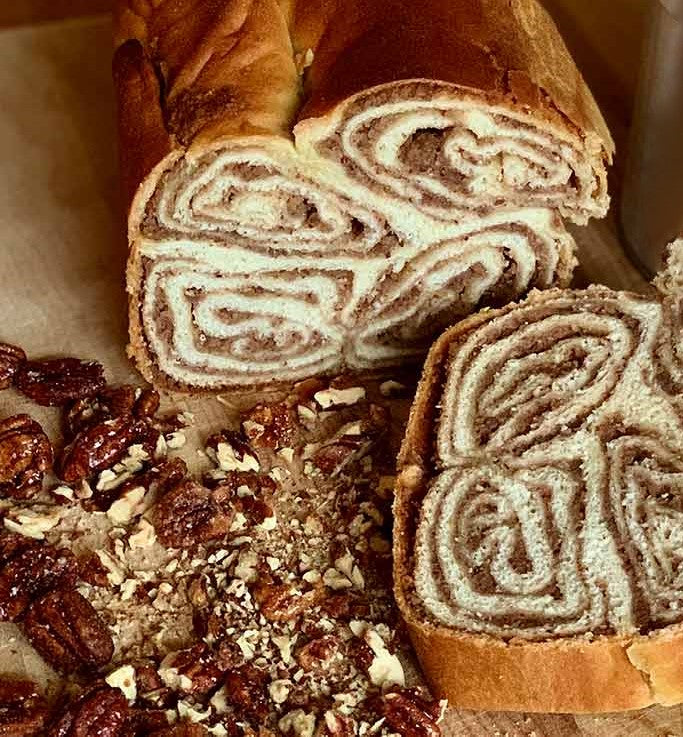This beautiful holiday bread turns out looking so cool that you'll think it’s impossible to make, but it’s really not that difficult! It’s a fun project to make with kids, and the smell of cinnamon, toasted pecans, and fresh bread baking will bring everyone to the kitchen. Guaranteed! There are so many recipes for this traditional Croatian bread; we adapted this one from many to include Fortune Favors The Classic pecans. The results are fantastic! Say “poh-vuh-teet-suh”!
Ingredients
Dough:
3 Tbsp warm water
½ tsp granulated sugar
2 tsp active dry yeast
½ cup whole milk
3 Tbsp granulated sugar
¾ tsp sea salt
1 Tbsp butter, melted
1 large egg, lightly beaten
¼ tsp pure vanilla extract
2 to 2 ½ cups all-purpose flour
Fortune Favors Filling:
¼ cup whole milk
6 Tbsp butter, melted
1 cup raw pecans
1 cup Classic Fortune Favors The Classic pecans
½ cup granulated sugar
¼ tsp sea salt
½ tsp ground cinnamon
1 large egg yolk lightly beaten
½ tsp pure vanilla extract
2 Tbsp honey or agave
Instructions
Make the dough:
In a small bowl, stir ½ tsp sugar, and yeast into warm water. Set aside until foamy (about 5 minutes)
In a medium saucepan, heat the milk to just below boiling (about 180°F), stirring occasionally. Allow to cool until it is about 110°F.
Once cooled, whisk in the melted butter, 3 Tbsp sugar, and salt to the milk until combined. Add egg, vanilla, and yeast mixture, and stir to combine.
Add flour into the bowl of a standing mixer fitted with a dough hook.
Pour wet ingredients into the flour and mix the dough with the dough hook until it forms a smooth, elastic ball of dough. (You can also mix and knead by hand).
If necessary, add up to 2 Tbsp more flour until dough is smooth and no longer sticky.
Turn dough out onto a lightly floured surface and form into a ball.
Place dough in a lightly oiled bowl and cover with a warm, damp towel. Let the dough rise for 1.5 hours in a warm place, or until doubled in size.
Make the filling:
While the dough is rising, put the milk and butter into the container of a blender or food processor and blend/process until the mixed.
Add pecans (both kinds), sugar, salt, and cinnamon and pulse a few times until the ingredients are combined and pecans are crushed into smaller pieces. Mix until uniform consistency, not quite a paste but a spreadable smooth texture.
Add egg yolk, vanilla, and honey or agave, and pulse to combine.
Allow mixture to stand at room temperature until dough is ready.
Assembly:
Line a 9 x 5 inch loaf pan with parchment paper and grease with butter. Set aside.
After the dough has doubled in size, remove it from the bowl and place on a well-floured surface.
Roll the dough into a rectangle about 18” x 17” in size. Be sure dough is thin but not so thin that you can see through it (about ¼” thick).
Spread the filling evenly on the dough, leaving about ½” at the edges bare. (If your filling has become too thick to spread, add warm milk ½ Tbsp at a time until it just reaches spreading consistency).
Staring at the edge of your rectangle, roll the dough tightly together making a jelly roll. Be sure to apply pressure and keep rolling tightly until it resembles a rope.
Gently stretch out the “rope” and lift it into your prepared loaf pan, making an “S” shape as you put it in. (To do this, fold the dough into thirds in your pan.
Cover the pan with a damp towel and let it sit in a warm place for at least 15 minutes while you preheat your oven to 350 degrees F.
Bake for 15 minutes at 350 degrees.
After 15 minutes turn down the oven to 300 degrees F and bake for an additional 45 minutes (about 1 hour total), or until done (will sound hollow when hit with a wooden spoon). Check your bread after about 30 minutes and cover with aluminum foil if it is getting too brown.
Remove bread from the oven. Cool for 20-30 minutes on a wire rack before removing from pan.
Cool completely before cutting and serving! This dense, rich bread freezes well too.
If you have questions about technique, history, process, and endless variations on povitiça — get to YouTube and enjoy the journey!

